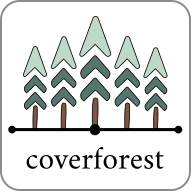Conformal regression using Jackknife+-after-bootstrap in a Pipeline#
This example demonstrates using CoverForestRegressor to perform Jackknife+-after-bootstrap in a scikit-learn pipeline with the diabetes dataset.
import matplotlib.pyplot as plt
import numpy as np
from sklearn import tree
from sklearn.datasets import load_diabetes
from sklearn.model_selection import train_test_split
from sklearn.pipeline import Pipeline
from sklearn.preprocessing import StandardScaler
from coverforest import CoverForestRegressor
from coverforest.metrics import average_interval_length_loss, regression_coverage_score
Load the dataset and split it into training and testing sets
X, y = load_diabetes(return_X_y=True, as_frame=True, scaled=False)
X_train, X_test, y_train, y_test = train_test_split(X, y, test_size=0.5, random_state=0)
Making a pipeline#
We’ll create a scikit-learn pipeline that normalizes the features first before fitting with CoverForestRegressor. Here, we specify method='bootstrap' to perform Jackknife+-after-bootstrap during fitting.
pipe_b = Pipeline(
[
("scaler", StandardScaler()),
(
"reg_b",
CoverForestRegressor(n_estimators=400, method="bootstrap", random_state=0),
),
]
)
We’ll now fit the pipeline on the training data.
pipe_b.fit(X_train, y_train)
Pipeline(steps=[('scaler', StandardScaler()),
('reg_b',
CoverForestRegressor(method='bootstrap', n_estimators=400,
random_state=0))])In a Jupyter environment, please rerun this cell to show the HTML representation or trust the notebook. On GitHub, the HTML representation is unable to render, please try loading this page with nbviewer.org.
Pipeline(steps=[('scaler', StandardScaler()),
('reg_b',
CoverForestRegressor(method='bootstrap', n_estimators=400,
random_state=0))])StandardScaler()
CoverForestRegressor(method='bootstrap', n_estimators=400, random_state=0)
Notice that the fit() method performs a hyperparameter search before the actual fitting, which as a result yields k = 1 and lambda = 0.1.
Inspecting individual tree#
The CoverForestRegressor retains all RandomForestRegressor’s post-train attributes and methods. When method='bootstrap', each subestimator in CoverForestRegressor is a scikit-learn’s DecisionTreeRegressor. Let’s take a look at one of these trees.
all_trees = pipe_b["reg_b"].estimators_
first_tree = all_trees[0]
first_tree
DecisionTreeRegressor(max_features='sqrt', random_state=441365315)In a Jupyter environment, please rerun this cell to show the HTML representation or trust the notebook.
On GitHub, the HTML representation is unable to render, please try loading this page with nbviewer.org.
DecisionTreeRegressor(max_features='sqrt', random_state=441365315)
We can use scikit-learn’s tree.plot_tree to plot individual trees.
plt.figure(figsize=(10, 6))
tree.plot_tree(
first_tree,
feature_names=pipe_b["scaler"].get_feature_names_out(),
max_depth=2,
proportion=True,
fontsize=9,
)
plt.show()
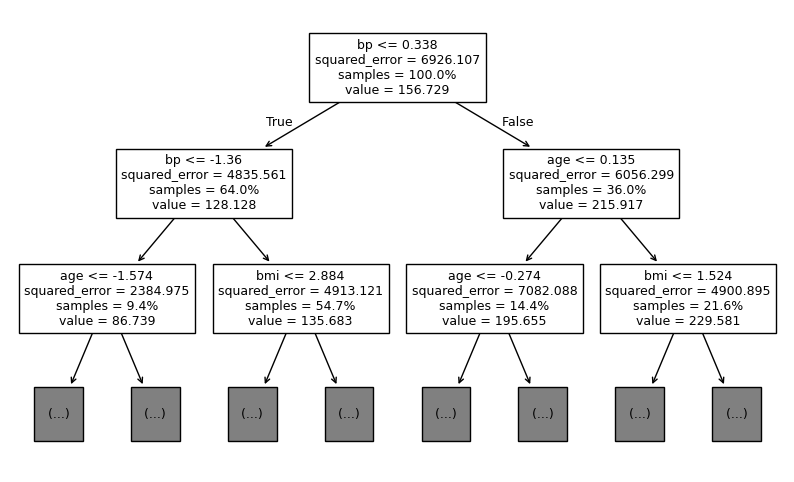
As another example, we also have access to the feature_importances_ attribute after training.
names = pipe_b["scaler"].get_feature_names_out()
importances = pipe_b["reg_b"].feature_importances_
fig, ax = plt.subplots()
ax.bar(names, importances)
ax.set_ylabel("Feature importances")
ax.tick_params(axis="x", labelrotation=90)
plt.show()
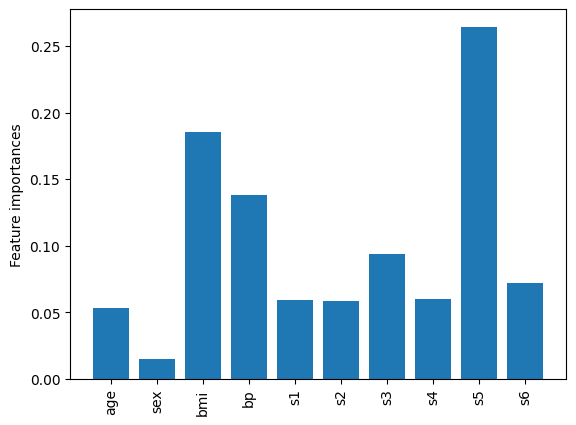
Making interval predictions#
Now we’ll make predictions with 95% coverage (\(\alpha=0.05\)). This will return both the point predictions and the interval predictions.
y_b_pred, y_b_interval = pipe_b.predict(X_test, alpha=0.05)
Here, y_b_pred is an array of point predictions, which are the single values predicted by the model. y_b_interval is an array of shape (n_test, 2) where the first column is the lower bounds, and the second column is the upper bounds of the intervals.
Let’s visualize these intervals. First, we define a convenient function that will be used to plot our predictions.
def plot_predictions_with_intervals(y_test, y_pred, y_interval):
"""Plot the test values, predictions, and prediction intervals"""
x = np.arange(len(y_test))
sort_idx = np.argsort(y_pred)
y_test = y_test.iloc[sort_idx]
y_pred = y_pred[sort_idx]
y_interval = y_interval[sort_idx]
plt.figure(figsize=(12, 6))
for i in x:
plt.vlines(i, y_interval[i, 0], y_interval[i, 1], color="blue", alpha=0.3)
plt.scatter(x, y_test, s=8, color="r", label="Actual Values", zorder=5)
plt.scatter(
x, y_pred, s=8, color="blue", label="Predictions", linewidth=2, zorder=4
)
plt.ylabel("Disease progression", fontsize=20)
plt.legend(fontsize="x-large")
plt.grid(True, alpha=0.3)
plt.tight_layout()
We’ll now use this function. From the theory, 95% of these intervals should contain the actual values of \(y\).
plot_predictions_with_intervals(y_test, y_b_pred, y_b_interval)
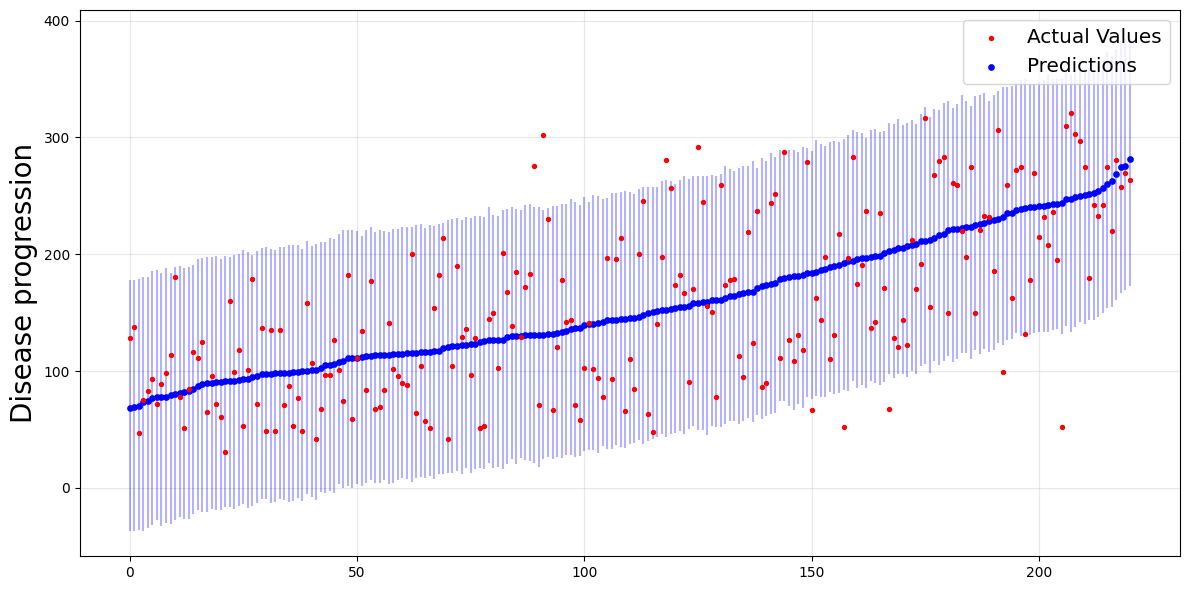
The intervals are the blue vertical lines, which are wide enough to contain most of the actual values (the red points).
Evaluations#
The coverforest.metrics module provides two metrics for evaluation of interval predictions.
average_interval_length_losscalculates the average interval length. Small values indicate that our model’s predictions are quite accurate.regression_coverage_scorecalculates the *empirical coverage`, that is, the proportion of intervals that contain the actual values. Higher coverage scores are better, especially when making risky decisions. The standard guaranteed lower bound on the coverage probability is \(1-2\alpha\). Nonetheless, in practice, a good conformal algorithm should have empirical coverage more than \(1-\alpha\).
print(f"Average length: {average_interval_length_loss(y_test, y_b_interval)}")
print(f"Empirical coverage: {regression_coverage_score(y_test, y_b_interval)}")
Average length: 216.6140370279263
Empirical coverage: 0.9547511312217195
For Jackknife+-after-bootstrap, the empirical coverage is above our target level of 0.95.
Comparison with CV+ and split conformal#
Let’s try conformal regression with CV+ and split conformal as well and see how they perform compared to the Jackknife+-after-bootstrap.
CV+#
To perform CV+, we instantiate CoverForestRegressor with method='cv'.
pipe_cv = Pipeline(
[
("scaler", StandardScaler()),
(
"reg_cv",
CoverForestRegressor(n_estimators=400, method="cv", cv=20, random_state=0),
),
]
)
pipe_cv.fit(X_train, y_train)
y_cv_pred, y_cv_interval = pipe_cv.predict(X_test, alpha=0.05)
plot_predictions_with_intervals(y_test, y_cv_pred, y_cv_interval)
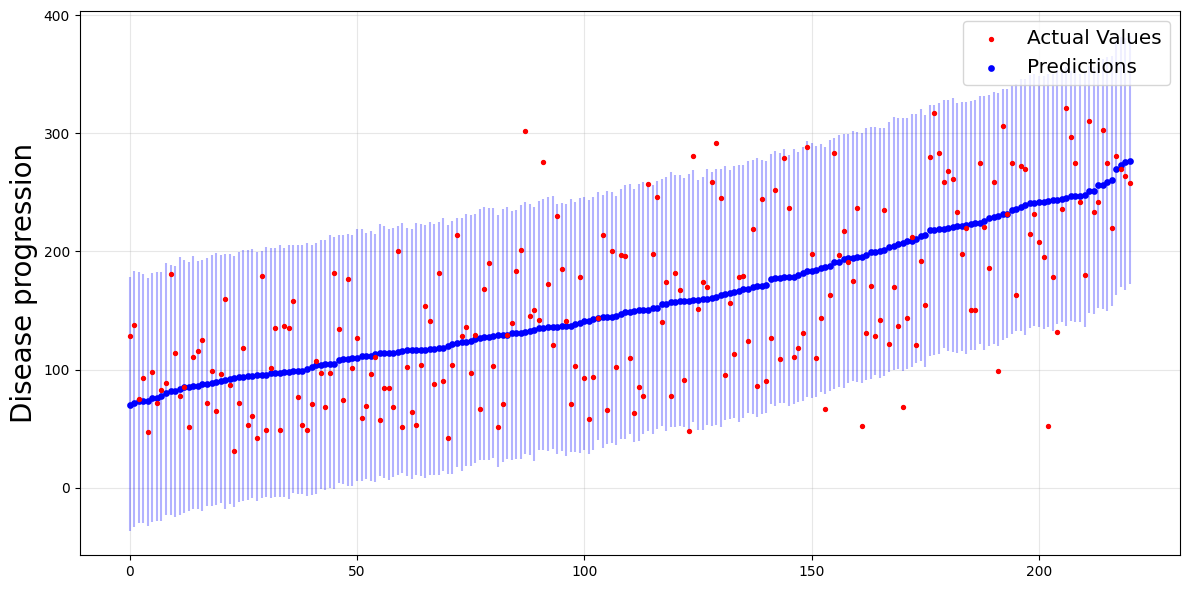
print(f"Average length: {average_interval_length_loss(y_test, y_cv_interval)}")
print(f"Empirical coverage: {regression_coverage_score(y_test, y_cv_interval)}")
Average length: 212.77281674208146
Empirical coverage: 0.9502262443438914
Compared to Jackknife+-after-boostrap, the average length and the empirical coverage are smaller.
Split conformal#
To perform split conformal, we instantiate CoverForestRegressor with method='split'.
pipe_sp = Pipeline(
[
("scaler", StandardScaler()),
(
"reg_sp",
CoverForestRegressor(n_estimators=400, method="split", random_state=0),
),
]
)
pipe_sp.fit(X_train, y_train)
y_sp_pred, y_sp_interval = pipe_sp.predict(X_test, alpha=0.05)
plot_predictions_with_intervals(y_test, y_sp_pred, y_sp_interval)
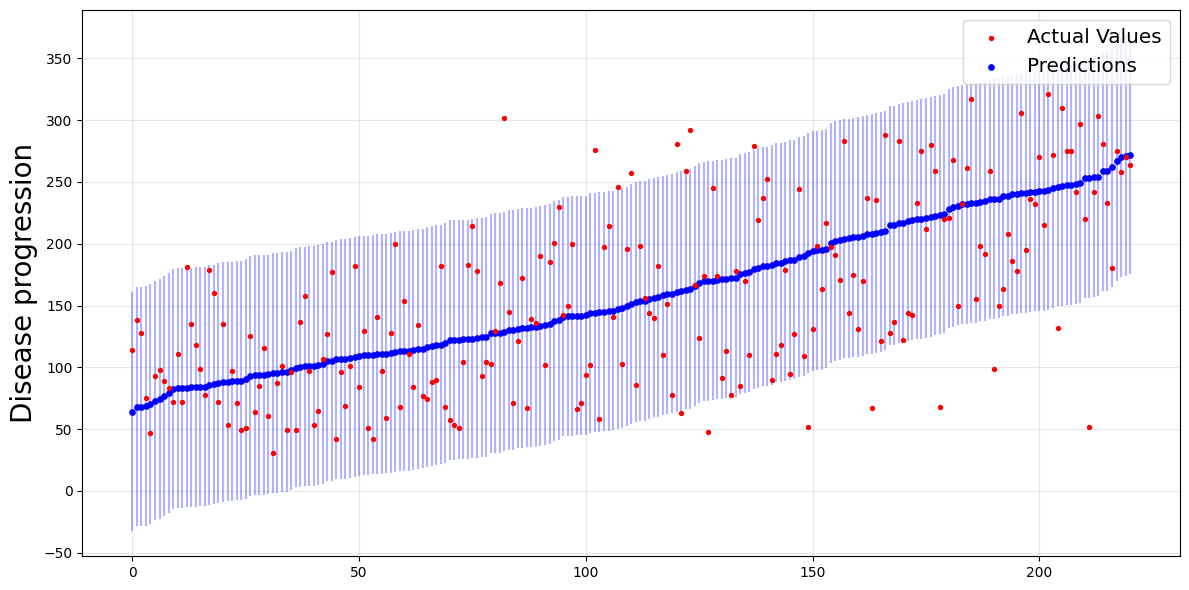
print(f"Average length: {average_interval_length_loss(y_test, y_sp_interval)}")
print(f"Empirical coverage: {regression_coverage_score(y_test, y_sp_interval)}")
Average length: 193.825
Empirical coverage: 0.9276018099547512
Even though the average length is smaller than the previous two methods, its coverage is below the desired level of 0.95.
Final notes#
The CV+ method is the only one with random forests as the sub-estimators
In the case of Jackknife+-after-bootstrap, the coverage guarantee in Kim et al.[1] relies on resampling the forest’s tree count from \(\operatorname{Binomial}(B (1-1/n)^m)\), where:
\(B\) is the initial number of trees
\(n\) is the number of training samples
\(m\) is the number of bootstrap samples.
The
fit()method inCoverForestRegressorautomatically sets \(B= \text{n_estimators}/(1-1/n)^m\) so that, on average, the number of trees to be fitted is \(\text{n_estimators}\), with standard deviation of \(\sqrt{\text{n_estimators}*(1- (1-1/n)^m)}\).CoverForestRegressoralso provides an option not to resample the number of sub-estimators by initiating withresample_n_estimators=False.Random forest leverages parallel computation by processing trees concurrently. Use the
n_jobsparameter infit()andpredict()to control CPU usage (n_jobs=-1uses all cores).For prediction, conformity score calculations require a memory array of size
(n_train × n_test × n_classes). To optimize performance with highn_jobsvalues, split large test sets into smaller batches.
